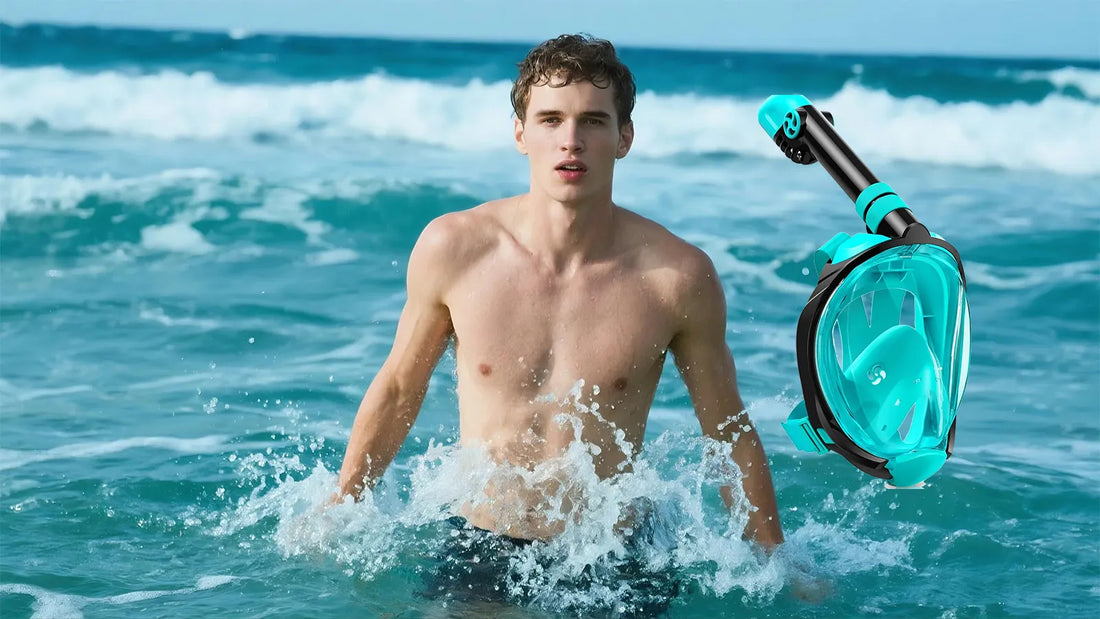The Allure of Full Face Snorkel Masks
Full face snorkel masks have become a favorite among snorkeling enthusiasts due to their innovative design and ease of use. Unlike traditional snorkels, these masks cover the entire face, allowing users to breathe naturally through both the nose and mouth. This feature eliminates the need for a separate mouthpiece, making the experience more comfortable for beginners and seasoned snorkelers alike. However, despite their popularity, full face snorkel masks have raised concerns among safety experts and medical professionals.
Understanding the Design and Functionality
Full face snorkel masks are designed to provide a panoramic view of the underwater world while ensuring a steady supply of air. The mask seals around the entire face, creating a watertight barrier that prevents water from entering. A built-in snorkel extends above the water surface, allowing the user to breathe without lifting their head. The design also includes a one-way valve system that prevents water from entering the breathing chamber. While this design seems efficient, it has several inherent flaws that can pose serious risks to users.
The Dangers of Carbon Dioxide Buildup
One of the most significant risks associated with full face snorkel masks is the potential for carbon dioxide (CO2) buildup. When you exhale, CO2 is released into the mask's breathing chamber. In traditional snorkels, this CO2 is expelled through the mouthpiece. However, in full face masks, the exhaled air can accumulate within the chamber, especially if the mask is not properly ventilated. Breathing in high levels of CO2 can lead to dizziness, confusion, and even loss of consciousness, which can be life-threatening in the water.
Risk of Restricted Airflow
Another concern with full face snorkel masks is the potential for restricted airflow. The mask's design relies on a single breathing tube, which can become obstructed by water, debris, or even the user's own breath. If the airflow is compromised, the user may struggle to breathe, leading to panic and potentially dangerous situations. Additionally, the mask's seal can create a vacuum effect, making it difficult to remove the mask quickly in an emergency.
Increased Risk of Drowning
Full face snorkel masks have been linked to an increased risk of drowning, particularly among inexperienced users. The mask's design can create a false sense of security, leading users to venture into deeper waters or stay submerged for longer periods than they can handle. In the event of a mask malfunction or CO2 buildup, the user may not be able to remove the mask quickly enough to avoid drowning. Furthermore, the mask's bulkiness can make it challenging to swim to safety or signal for help.
Potential for Mask Leaks and Fogging
While full face snorkel masks are designed to be watertight, they are not immune to leaks. Improper fit, damaged seals, or excessive movement can cause water to enter the mask, leading to discomfort and impaired vision. Additionally, the mask's large surface area can trap moisture, causing the lens to fog up. Fogging can obscure the user's view, making it difficult to navigate underwater and increasing the risk of accidents.
Limited Compatibility with Safety Gear
Full face snorkel masks are often incompatible with other safety gear, such as life jackets or flotation devices. The mask's design can interfere with the proper fit and function of these essential safety tools, reducing their effectiveness in an emergency. This incompatibility can be particularly dangerous for inexperienced swimmers or those who are not confident in their swimming abilities.
Alternatives to Full Face Snorkel Masks
Given the risks associated with full face snorkel masks, many experts recommend using traditional snorkels instead. Traditional snorkels are simpler in design, with a separate mouthpiece and mask that allow for better airflow and easier removal in an emergency. While they may require some practice to use effectively, traditional snorkels offer greater safety and reliability for underwater exploration. Additionally, users can opt for snorkels with advanced features, such as dry-top valves or purge systems, to enhance their experience without compromising safety.
Tips for Safe Snorkeling
Regardless of the type of snorkel you choose, safety should always be a top priority. Here are some tips to ensure a safe and enjoyable snorkeling experience:
- Always snorkel with a buddy and stay within sight of each other.
- Choose a snorkel that fits properly and is comfortable to wear.
- Practice using your snorkel in shallow water before venturing into deeper areas.
- Be aware of your surroundings and avoid strong currents or hazardous marine life.
- Regularly check your equipment for signs of wear or damage.
- If you experience any discomfort or difficulty breathing, remove your snorkel immediately and seek assistance.
Educating Yourself on Snorkeling Risks
Before embarking on a snorkeling adventure, it's essential to educate yourself on the potential risks and how to mitigate them. Understanding the limitations of your equipment and being aware of your own abilities can help you make informed decisions and reduce the likelihood of accidents. By staying informed and prioritizing safety, you can enjoy the beauty of the underwater world without putting yourself at unnecessary risk.
Full face snorkel masks may offer convenience and a unique experience, but they come with significant dangers that cannot be ignored. From CO2 buildup to restricted airflow and increased drowning risk, these masks pose serious threats to users. By opting for traditional snorkels and following safety guidelines, you can ensure a safer and more enjoyable snorkeling experience. Remember, the ocean is a beautiful but unpredictable environment, and your safety should always come first.

